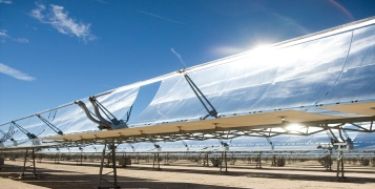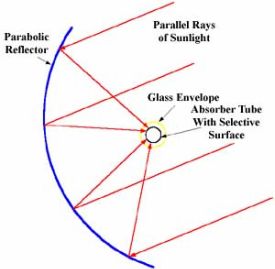|
Linear Solar Concentrators
Linear solar concentrators use trough-shaped mirrors to reflect the sunlight onto a pipe containing a fluid. The fluid gets hot enough to produce steam. The trough mirror is in the shape of a parabola. Parabolas have the unique property of reflecting incoming light to a central focal point, thereby concentrating it.
Generally the troughs run north-south and track the motion of the sun from east to wet for maximum efficiency. The trough surface is generally silver or aluminum for high reflectivity. The tube running along the focal line is called a receiver and can be coated with anti-reflective coating to more efficiency capture light rays sent towards it. The receiver is also sometimes placed inside a glass tube. The tube allows light to pass through but traps radiant heat and the small air space acts to insulate the receiver and minimalize heat loss. Temperatures of the fluid in the receiver can be as high a 400-600 degrees F. The fluid might simply be water, but more commonly it is oil because of oil’s greater thermal density. After the oil is heated by passing through a series of troughs, it goes to a heat exchanger where the energy generates steam to drive turbines and produce electricity. Some plants gain additional efficiency by capturing the heat still in the steam after it’s driven the turbines to warm water or other uses. LinksClick here to go to Solar Energy Click here to go to Concentrating Solar Energy Systems Click here to go to Alternative Energy Primer Home from Linear Solar Concentrators |

 Parabolic troughs have a pipe positioned along the focal line of the collector. A number of these troughs can be strung together to increase the energy output.
Parabolic troughs have a pipe positioned along the focal line of the collector. A number of these troughs can be strung together to increase the energy output.